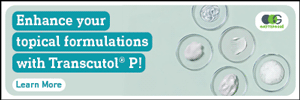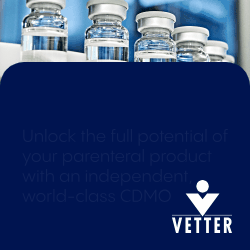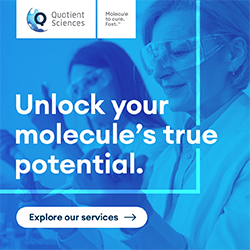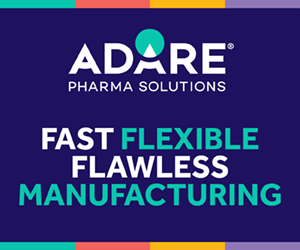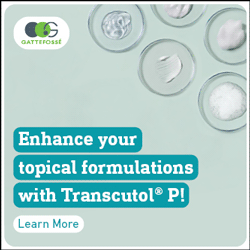Bioavailability & Solubility
CONTROLLED RELEASE - How Advanced Excipient Knowledge is Shaping the Future of Controlled-Release Formulations
Matthias Knarr, PhD, and True Rogers, PhD, review the latest insights behind CR formulations using HPMC excipients and how HPMC substitution specifically can assist formulators in developing cutting-edge CR delivery systems with differentiated performance.
PRECLINICAL/CLINICAL STUDIES - Preclinical Toxicology vs Clinical: Key Considerations in Using Lipid-Based Formulations
Anette Müllertz, PhD, Grace Furman, PhD, and Lisa Caralli say developers should first understand the developability challenges for their molecule, then a toolkit of enabling technologies can be identified to overcome those factors and individually leveraged to create fit for purpose formulations for use in preclinical and clinical studies.
Serán Bioscience Announces $200-Million Strategic Growth Transaction & Plans for New Commercial Facility
Serán Bioscience recently announced a strategic growth transaction of more than $200 million. Bain Capital Life Sciences led the transaction, while existing investor Vivo Capital…
Evonik Starts Operation of New Spray Drying Facility for Pharmaceutical Oral Excipients
Evonik has officially opened a new facility for drying aqueous dispersions of EUDRAGIT polymers at its site in Darmstadt. The new double-digit million-euro excipient manufacturing…
FORMULATION DEVELOPMENT - Solubility-Enhancing Technologies in Pharmaceutical Development, a Mini-Review
Timothy Pas, PhD, and Vincent Levet, PhD, believe different solubility-enhancing technologies can be used by developers, and with different advantages and drawbacks, linked to payload, manufacturability, tolerability, and physical and chemical stability, effectively navigating solubility-enhancing solutions is multifaceted.
SILICON-STABILIZED HYBRID LNPS - Next-Generation Delivery of RNA Therapeutics
Suzanne Saffie-Siebert, PhD, Michael Welsh, PhD, Nissim Torabi-Pour, PhD, and Flavia M. Sutera, PhD, review current shortcomings, as well as some accompanying manufacturing challenges, and will show how they can be addressed by SiSaf’s silicon-stabilized hybrid LNPs.
Avanti Polar Lipids Becomes Avanti Research, a Croda Brand
Avanti Polar Lipids, a global leader in lipids, recently announced its renewed offering for researchers and its transformation to Avanti Research. This marks another exciting…
Dosing Completed in 115 Participant Bioavailability/Bioequivalence Clinical Trial for Proprietary Sleep Apnea Drug Candidate
Incannex Healthcare Inc. recently announce that it has completed participant dosing in the IHL-42X Bioavailability/Bioequivalence (BA/BE) clinical trial. IHL-42X comprises two drugs, dronabinol (synthetic delta-9-tetrahydrocannabinol…
WHITEPAPER - Versatility of Geleol™ Mono- and Diglycerides NF
Geleol exerts different functional roles, depending on the drug, formulation, and the process applied. It may serve as carrier and release modifier for oral formulations and plasticizer in tablet film coating processes. It may be combined with polymers and/or other non-digestible lipids like Compritol®….
OKYO Pharma to Initiate Neuropathic Corneal Pain Trial for OK-101
OKYO Pharma Limited recently announced its plan to advance OK-101 into a Phase 2 clinical trial of neuropathic corneal pain which is expected to begin…
Oragenics Improves Intranasal Drug Formulation for Treating Concussed Patients
Oragenics, Inc. recently announced it has developed a new formulation for its novel neurosteroid. Oragenics’ lead drug candidate for concussion, ONP-002, is a new chemical…
Assembly Biosciences Presents New Data Highlighting Hepatitis D Virus Entry Inhibitor
Assembly Biosciences, Inc. recently announced new data for ABI-6250, the company’s orally bioavailable, small molecule hepatitis D virus (HDV) entry inhibitor candidate, featured in a…
SPECIAL FEATURE - Outsourcing Formulation Development & Manufacturing: Going Beyond the Science to Become True Partners
Contributor Cindy H. Dubin speaks with leading CDMOs about how they are adapting to bio/pharma client needs, their capabilities in handling complex molecules, and how they are transforming from specialist contractors to true partners.
FORMULATION FORUM - Advances in Drug Delivery by Antibody Drug Conjugates (ADCs)
Shaukat Ali, PhD, and Jim Huang, PhD, focus on two aspects of drug delivery through ADCs. One, where an antibody is conjugated via a ligand with functionalized LNPs carrying cytotoxic drugs; and two, where an antibody is conjugated directly with drug through a linker at the specific site.
AMORPHOUS SOLID DISPERSION SPECIATION - Impact of Polymer Chemistry & Drug Properties
Wesley K. Tatum, PhD, focuses on the use of in vitro techniques for characterizing ASD performance and on how these techniques can be used to help better understand the role of polymer chemistry in ASD performance.
EXECUTIVE INTERVIEW - Lonza: Navigating Today’s Challenges in Drug Solubility & Bioavailability
Adi Kaushal, Director and Technology Head, Bioavailability Enhancement at Lonza, discusses solubility and bioavailability challenges and Lonza’s approach.
EXECUTIVE INTERVIEW - PCI Pharma Services: A Consultative Approach to High Potency Formulation Development
David O’Connell, Director of Scientific Affairs at PCI Pharma Services, explains how important it is to choose the right CDMO partner to accompany you throughout the drug product lifecycle.
Roquette Unlocks the Power of Flexibility With Launch of New Flex Softgel Capsule Shell System
Roquette recently announced the launch of its new LYCAGEL Flex hydroxypropyl pea starch premix for nutraceutical and pharmaceutical softgel capsules. Built on Roquette’s market-first LYCAGEL pea…
Data From First Human Study Demonstrate Excellent Performance of Zerion Pharma’s Dispersome Technology
Zerion Pharma A/S recently announced positive results from the first human clinical study of a Dispersome formulation of the drug Ivacaftor, a pharmaceutical used to…
EXECUTIVE INTERVIEW - Adare Pharma Solutions: Expanding Capabilities to Exceed Customer Expectations
Tom Sellig, CEO of Adare Pharma Solutions, discusses how he has realized various achievements and about the company’s focus on addressing special needs in the market, its global expansion, and where he expects to take the company in the future.
Bioavailability and Solubility Challenges
Given that a large number of drugs fail to reach the market due to poor solubility and bioavailability, the industry is seeking various methods to mitigate this challenge while many choose to re-formulate existing product candidates. Either way, the demand for novel bioavailability and solubility enhancement methods has grown significantly. To cater to this increasing demand, many contract manufacturers and technology developers have emerged.
What is Solubility?
Solubility is the ability for a drug to be dissolved in an aqueous medium. Drug solubility is defined as the maximum concentration of a substance that can be completely dissolved in a given solvent at a certain temperature and pressure level.
Solubility of drugs is measured by the amount of solvent needed to dissolve one gram of the drug at a specific temperature. For example, a drug that is very soluble needs less than one part solvent to dissolve one gram of the drug. How soluble a drug is varies widely—a drug that is considered soluble needs 10-30 parts, one that is slightly soluble needs 100-1,000 parts and one that is practically insoluble or insoluble needs more than 10,000 parts. How soluble a drug is depends on the solvent, as well as temperature and pressure.
Since 1975, approximately 60 marketed drugs have leveraged solubilization technologies to enhance oral bioavailability. In the preceding 36 years, from the time the FDA required submission of an NDA in 1938, solubilization technology was virtually unused on a regular basis. Apparently, the disease areas focus, drug discovery methodologies, and the lack of mature solubilization platforms restricted the use prior to the 1970s.
In comparison, the past nearly 4 decades have shown robust growth in the reliance on solubilization platforms, accounting on average for around 9% of all NMEs approved from 1975 through 2022, and more than 10% in the past decade. Some years stand out to validate the need and use of solubilization platforms. For example, in 2005, 20% of NMEs approved used technologies including solid dispersion, lipid, and nanocrystal platforms. The data for the most recent 4-year period (2010-2013) seems to represent a slight decline in growth, but it is still early in the decade, and the data set is relatively small. Based on the trends throughout the past 4 decades and the changing chemical space in drug development, we expect the decade will show additional and significant current growth in use of solubilization technologies once we have visibility into the full 10-year period.
Bioavailability & Solubility Impediments
The biggest impediment in addressing bioavailability issues likely lies with a lack of deep familiarity with enabling technologies. Improving drug bioavailability begins with a thorough evaluation of the API’s physical and chemical properties in relation to solubilization in the dose, but more importantly its dissolution in vivo at the site of absorption.
These technologies, such as nanoparticles, cocrystals, computer-aided prodrug design, and electrospinning, represent innovations aimed at enhancing the solubility of a candidate molecule, particularly in the gastrointestinal tract. Technologies such as electrospinning, deep eutectic solvents, and ionic liquids are upcoming formulation approaches to enhance drug solubility, and as the science matures, and the relative strengths and weaknesses are better understood, we expect to see further application of these innovative approaches. They have shown to be successful for some compounds, and have a place alongside other bioavailability enhancement technologies, where each strategy has its benefits and corresponding liabilities. For them to be successful and widely adopted however, they will also have to provide a compelling benefit compared with other well-understood, and commercially precedented technologies, such as amorphous solid dispersions and lipid-based formulations.
Extreme compounds require either significant amounts of stabilizers to maintain the amorphous state or they are not amenable to common manufacturing technologies with reasonable cost of goods due to their low solubility in organic solvents. These include amorphous solid dispersions using polymethacrylate, cellulose, or povidone-based polymeric carriers, she says. In addition, thermostability of new molecular entities becomes an issue as most new molecules have melting points well above 400°F. Alternative production methods for amorphous solid dispersions can address these issues.





